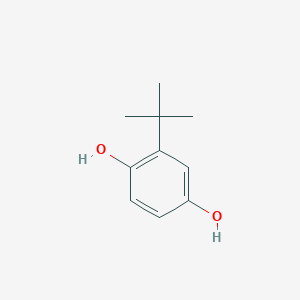Detail Information of Xenobiotics
| General Information of Xenobiotics (ID: XEO01129) | ||||||
|---|---|---|---|---|---|---|
| Xenobiotics Name |
2-tert-butylhydroquinone
|
|||||
| Xenobiotics Type |
Health or Environmental Toxicant(s)
|
|||||
| Classification |
Environmental Pollutant
|
|||||
| Structure |
<iframe style="width: 300px; height: 300px;" frameborder="0" src="https://embed.molview.org/v1/?mode=balls&cid=16043"></iframe>
|
 |
||||
| 3D MOL | 2D MOL | |||||
| PubChem CID | ||||||
| DME(s) Modulated by This Xenobiotics | ||||||
| DME(s) Induced by This Xenobiotics | ||||||
| Small intestine reductase (AKR1B10) | DME Info | Homo sapiens | [1] | |||
| Aldo-keto reductase 1C1 (AKR1C1) | DME Info | Homo sapiens | [2], [1] | |||
| Carboxylesterase 1 (CES1) | DME Info | Homo sapiens | [3] | |||
| Cytochrome P450 1A1 (CYP1A1) | DME Info | Homo sapiens | [4], [5] | |||
| Cytochrome P450 2A6 (CYP2A6) | DME Info | Homo sapiens | [6] | |||
| Mephenytoin 4-hydroxylase (CYP2C19) | DME Info | Homo sapiens | [6] | |||
| Cytochrome P450 2C9 (CYP2C9) | DME Info | Homo sapiens | [6] | |||
| Glutathione reductase (GSR) | DME Info | Homo sapiens | [7] | |||
| Glutathione S-transferase mu-1 (GSTM1) | DME Info | Homo sapiens | [8] | |||
| Glutathione S-transferase pi (GSTP1) | DME Info | Homo sapiens | [9] | |||
| Quinone reductase 1 (NQO1) | DME Info | Homo sapiens | [10] | |||
| Thioredoxin reductase TR1 (TXNRD1) | DME Info | Homo sapiens | [11], [1] | |||
| UDP-glucuronosyltransferase 1A6 (UGT1A6) | DME Info | Homo sapiens | [12] | |||
| UDP-glucuronosyltransferase 1A9 (UGT1A9) | DME Info | Homo sapiens | [13] | |||
| UDP-glucuronosyltransferase 2B7 (UGT2B7) | DME Info | Homo sapiens | [13] | |||
If you find any error in data or bug in web service, please kindly report it to Dr. Yin and Dr. Li.

